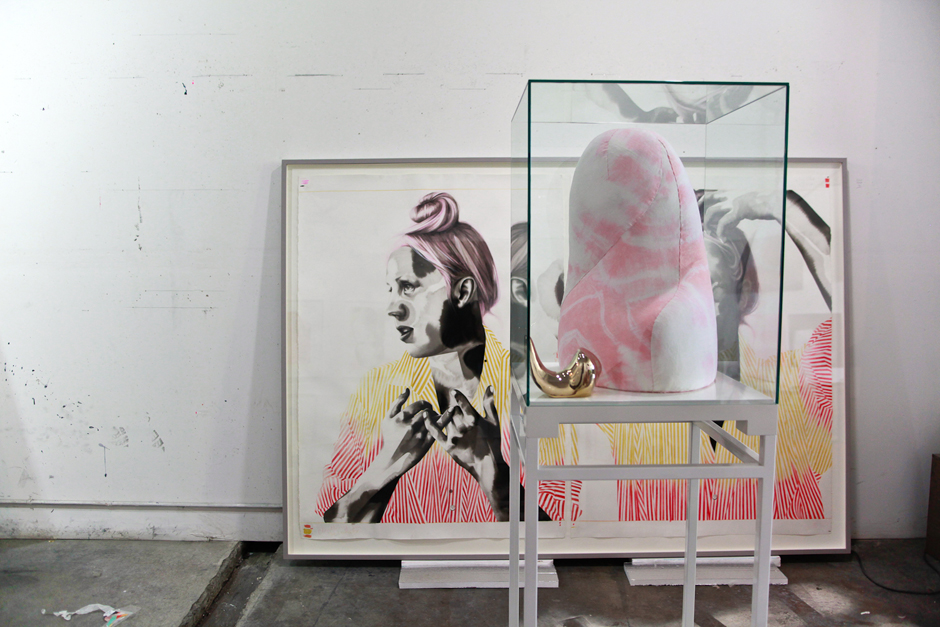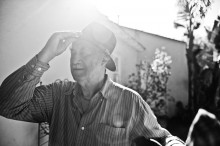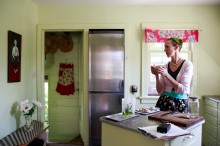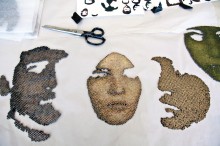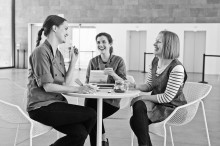Storm Tharp
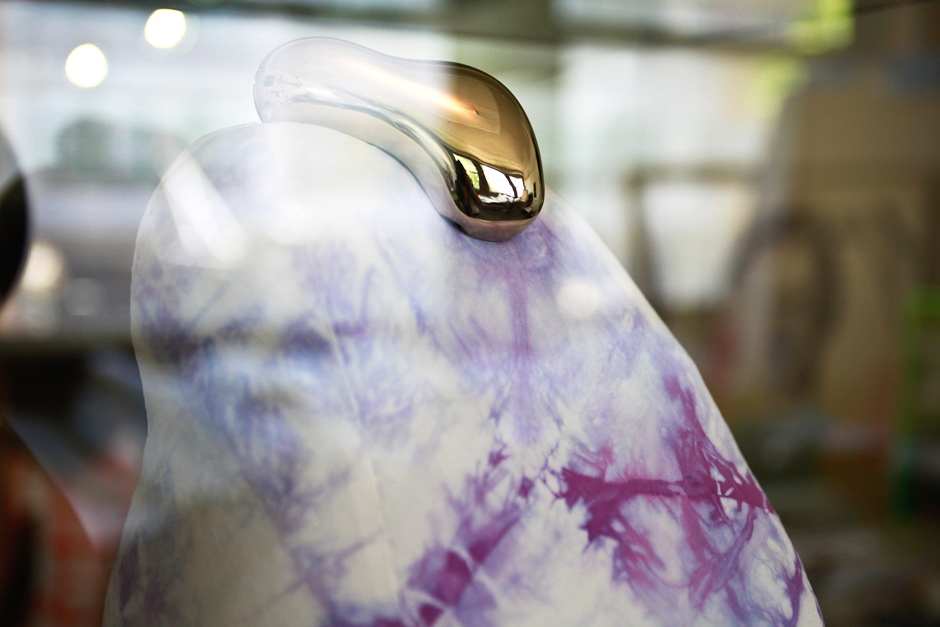
On my shelves are numerous books on the craft of fiction, many of which are vestiges of my grad school days that I now don’t open up nearly as often as I should. In all these anthologies there are often sections in which writers, whether in interview or essay form, attempt to explain why they write. The gist always seems to be same: that writing is a way to make sense of life, particularly those aspects that most of us find too difficult to talk about— fear, death, secrets, war, melancholy, sex, confusion. Many of these writers and their explanations are eloquent, stunningly metaphorical and therefore quite quotable, but in my mind American novelist Herbert Gold puts it best, “I write to master my experience.”
And I think Gold’s simple but hefty statement can easily be applied to Storm’s art and the tilts and turns in his ever-evolving practice. Storm’s work has encompassed many mediums— video, installation, sculpture, painting and drawing, but when we visited him in his Portland studio about a year ago he had become quite well-known for his mixed-media portraits. Those portraits, rendered painstakingly with colored-pencils and rigorous and exacting manipulations of water and ink present beautiful, but almost grotesque characters with raw, ragged emotional edges in plain sight. They make me feel dazzled and gutted, all at once.
Though these portraits had become Storm’s most popular works, when we arrived at his studio we realized he was in the midst of… well, a crisis of sorts. Essentially, Storm had come to a point in his practice in which he was re-examining and questioning, as he put it, “the results of my efforts.” Initially, we got worried— we had come to his studio with the intention of creating a video that would reveal his process, mainly with regards to his portraits, but it was clear that Storm’s focus was evolving and we had caught him in the throes of a transformation…so, quickly, we modified our goal, and simply aimed to share a bit of this crucial moment in the trajectory of his work. The work that was present in his studio veered away from portraiture, and instead his works on paper expressed physicality without faces and his smooth tie-dyed sculptures also referenced the body in their organ-like forms. I have to say, I was floored by Storm’s willingness to invite us in at such a fluctuating, uncertain time in his practice— I found him to be brave, vulnerable, and just incredibly honest about where he was at. It can’t be an easy thing to answer other people’s questions when you have so many of your own. But Storm seemed to recognize that however painful or uncomfortable transitions are, for him, the goal is to always approach his art with authenticity and rigor, and to honor the work by pushing its possibilities, fine tuning, obsessing, pushing again… and slowly mastering that experience, on and on again.
Storm’s show Tiger opens on September 30, 2014 in Portland at PDX Contemporary Art.
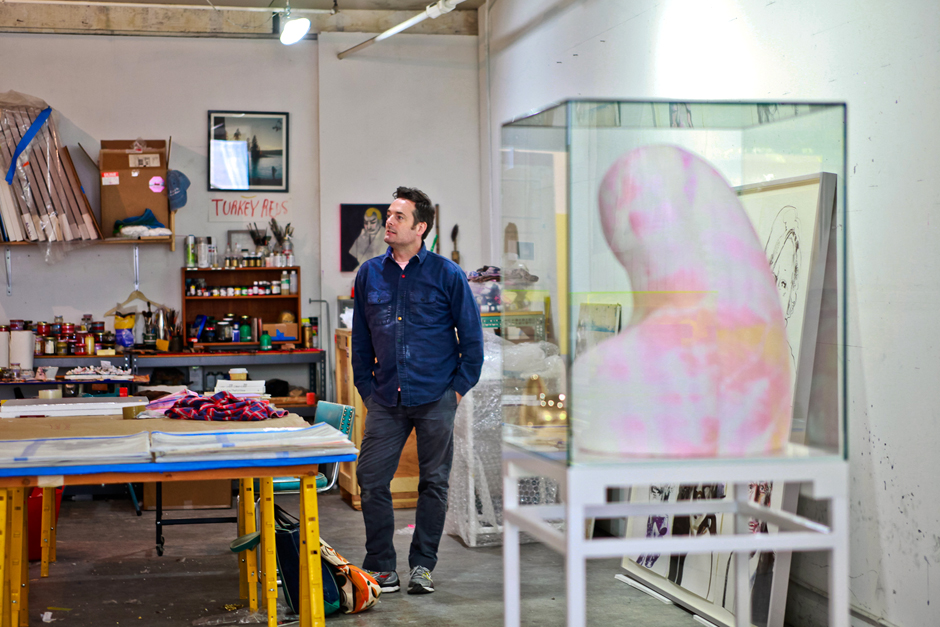
How would you describe your subject matter or the content of your work?
The answer to this question is something that I have thought about for as long as I have been showing my work and it has never been an easy thing to describe. It’s not that it’s beyond words, but I have found that language (or at least my use of it) does not express my intentions.
Over the past year and a half, I have made a lot of work that plainly re-examines my surroundings and how the exposure to and the comprehension of art history underlies many of my artistic choices as well as how I move through my life. I have been curious about the perceptions of what is regarded as representational and abstract, etc. And it has resulted in this vague and somewhat contentious argument with myself. All of the work that I have made in the last year or so has revolved around this question and others like it.
I am deflecting the question a bit – because I feel my work is changing. And more importantly, I feel my intellect has shifted. I have never questioned the results of my efforts as much as I have in the past three years – and to that – this question – this doubt – is what my work is about. Even the most confidently affirmative works I have made bubble up with a kind of anxious worry.
What mediums do you work with?
I work with ink, water, gouache, fabric dye, cotton paper and fabric. The majority of the work I have made is two dimensional and regarded as drawing. The sculptural works are often extensions of themes established in drawing and executed in ceramic, video and installation. I have recently returned to oil painting to challenge painterly inclinations I have found in working with very thick gouache on paper. The results so far have been rewarding.
With regards to your ink portraits you have a very specific practice— can you tell us more about this process and how it has evolved?
The portrait work that you speak of grew out of summer experiments about 10 years ago. I had set out to invent a new way of drawing. I did not necessarily invent a new way. But I did find a new way for myself. Initially, the technique was used to imbue chance and risk into the work – so that I would not be tempted to draw as I was trained, but rather let the medium determine the fate of the drawing for me. The surfaces were intoxicating and the ambiguity of form was very freeing. After a few years and many portraits later, this risk changed into something that I could control and understand, and in a way the freshness and joy of unknowing was altered permanently. I spent the past year trying to invent a new way to draw, and instead found myself asking: What to draw? Why to draw? Ultimately, it has led to painting and thinking like a painter.
Your portraits have a slightly warped and elusive quality; do you have narratives in mind for each piece?
If the portrait is based on a likeness or a person that I can recognize, then the narrative speaks to me in an almost subconscious way. The narrative expresses itself with some rigor as to what is necessary, what is essential – but I’m also editing and questioning constantly what is vulgar, wrong, un-necessary. If the portrait is unknown from the beginning – the narrative changes with every brush stroke. Until of course, some kind of handsome feature is established and I begin to understand who I’m making. Then the narrative begins to fall in line. But for example, sometimes the gender is not quite worked out until mid way – and so the narrative can be this big soft world around a character or person who is not yet formed. You could take that last sentence and answer your first question with it.
Do you consider your work to be autobiographical at all; does personal history work its way into your art?
Absolutely. Proudly.
I’m a bit of an open book. In many ways, the artwork gives meaning to or license for what I am capable of. Not so much by way of facility, but perhaps by way of thinking. In other words, what makes the work worthwhile is when its tapping into the most personal of regions. And that can be unsettling – especially if those regions are murky, unknown and inherently wrong. Of course the opposite is true as well.
Im 44 years old and I still catch myself wanting my work to fit some idea that has been perpetuated by and approved by a larger populous. I have to remind myself frequently that it’s better when my work makes me uncomfortable. The paradox is difficult for me to accept. The clichés abound.
What influences outside the visual arts inspire and impact your approach to making work?
Oh God.
Seriously, this could take me forever to answer.
Although I could be entirely better read – I don’t think there is anything as influential as the written word. Fiction, non-fiction, poetry, interviews – you name it.
The Peter Doig monograph from last year, No Foreign Lands has beautiful writing in it. Particularly from Hilton Als and Stéphane Aquin. I had the book in my studio – and after a few painting failures led me to sit down and change gears, I decided I should read it. It set the tone for what I needed to do next. It led me to the journals of Eugène Delacroix and his time spent in Morocco. In this way, reading is so valuable. It leads me through my interests from one thing to another.
That said, my reading list is very long. When I think of books, I think of those written by Nabokov, Cheever, Marilyn Robinson, Christopher Isherwood. . . But really, it’s the way that sentences are formed, the nuance and poetics of language that captivates me. Joan Didion is masterful in this regard. And of course, Wallace Stevens. I feel very lucky to have Jon Raymond and Emily Chenoweth as friends. The spines of their books sit high on my shelf alongside the writers they have encouraged me to read.
Film, obviously – is a huge influence. But I will spare you the details that are quite obvious, I’m certain. Same can be said of athletics, fashion and politics.
What does having a physical space to make art in mean for your process, and how do you make your space work for you?
In 2011, I made a body of work for the Portland Institute for Contemporary Art (PICA). I worked closely with the curator, Kristan Kennedy – who, knowing that I was itching to move beyond what I had been making in my studio, looked at a still life I had created at the end of my dining room table and said to me – “do that!” It caught me off guard and took me a few minutes to recognize the clarity of her idea. The idea being: the enthusiasm and care that I put into my surroundings is a legitimately creative act and when considered within the principals that I regard dear – a noble one.
So, I made a show about the placement of things. It was called, High House.
“The adventurous state of mind is a high house.”
– Agnes Martin
The experience of making the work and installing the work turned out to be quite life-changing. The new paintings I have made since 2013 are a directly related to the ideas I proposed in that installation.
Is there something you are currently working on, or are excited about starting that you can tell us about?
I am always excited to do the next thing, and for me that will be more painting. Another foray into abstraction. We’ll see where it leads.
But first, I have two exhibitions this fall. I arrived home recently from Berlin where I showed new work at Feldbushwiesner. I had never been to Berlin before and my show with the gallery was my first. It was a great experience. There is so much wonderful art work in Berlin. It invigorated me to be better and work harder.
And on September 30th, I open a show of new paintings at PDX Contemporary Art in Portland. I have been with Jane Beebe and PDX for 18 years and this exhibition will be my 10th solo show with the gallery. (Whoa! I just did the math.) I’m really excited. And a little nervous, as usual.
Do you see your work as relating to any current movement or direction in visual art or culture? Which other artists might your work be in conversation with?
I don’t really. I desperately want to feel that communal crush and connection.
That kind of dance-floor-feeling of a great song at a great party. But I don’t feel it. Which is OK. I think it’s common to feel outside of it all. But sometimes it makes me wonder if I’m a weirdo. That said, I recognize that my work is sometimes out of step with what’s going on, and I have been in this position before. I just need to keep doing it. It’s a tough rule. I have faith.
I love the work of Nicole Eisenman. The paintings, the sculpture – all of it.
Her work at the 2013 Carnegie International just blows me away. I am enamored by how the painting flows so fiercely into figurative sculpture and how effortless and gutsy it looks.
Jeffry Mitchell (from Seattle) is another artist that I greatly admire. We have a few attributes in common and I adore his work. If I could ever be thought of in the same breath as Jeff, I would be very pleased.
And while we’re at it – lets just make a dream team of Todd Haynes, PJ Harvey and Dan Bejar as well.
How do you navigate the art world?
I am grateful for the friendships that I have and the opportunities that I have been afforded. Whether people or places, these highlights have come to me the way good things often come – naturally. I have gone out on a limb a few times, ignoring my instincts, attempting to change course or get a break or a foot in the door and I find it does not suit me. Nor has it really worked.
I would not be here without the help and guidance from the people I have already mentioned. Stephanie Snyder, who curates the Cooley Gallery at Reed College has been invaluable to me as a friend and editor. She reminds me why I need to keep working.
It takes a huge amount of guts and spark and strength to get the work done in the studio – and although it may sound old-fashioned, I believe my efforts belong there. That said, I want to make art for the rest of my life and it does require that I get out and say hello. And thank you. And congratulations.
What risks have you taken in your work, or for your work?
I have decided to be an artist instead of being almost anything else in the world.
That is a risk. I have decided not to have children very much with the idea of art making in mind – a huge risk. I risk my health, namely my nerves for my work. I risk my liver for my work. I risk looking like a huge dumb-ass in my work. I risk saying too much in my work. I risk being a cliche in my work. I risk almost everything in my work. As long as I don’t risk the good lovin’ from my friends and family for my work – I’m good.
Words of wisdom?… a motto, favorite quote?
I have always loved the idea of No Regrets.
Are you involved in any upcoming shows or events? Where and when?
This one just opened:
TURN / FELDBUSCHWIESNER / Berlin
September 30-November 1, 2014
TIGER / PDX CONTEMPORARY ART / Portland
To see more of Storm’s work:
http://pdxcontemporaryart.com
http://www.galeriebertrand.com
http://www.feldbuschwiesner.de
